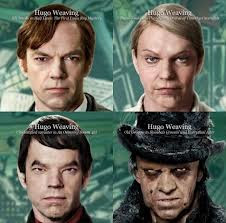No really, I don't think any of these films should be nominated.
Nominees
Hitchcock
The Hobbit: An Unexpected Journey
Les Miserables
3. Hitchcock
This is easily the worst offender. It's okay in a biopic to not have your actors look exactly like their historical counterparts. It's not okay to have them look cartoonish. Half the time Anthony Hopkins looked more like Elmer Fudd than Alfred Hitchcock. I doubt very much that this film is nominated because Scarlett Johansson had a wig that looked like Janet Leigh, but instead for the Hitchcock makeup, in which case I have no clue what happened here.
2. Les Miserables
There was actually a lot of really good work here: the level of detail with the dirty teeth, every hair in - or appropriately out of - place, the gaunt faces of revolutionaries, etc. There was an awkward tension though between reality and fantasy. There's something gritty and raw in Valjean escaped prisoner, something painful in his face that I believe was as much the makeup department as Jackman's performance. But then all the prostitutes look nearly like Heath Ledger's Joker. The tension between the stagey musical conceits and the epic drama of angry men was awkward and I think the makeup choices have something to do with that. But what bugs me most is how poorly done most of the aging was. Valjean and Javert go through a 20 year journey together and they hardly look any worse for the wear by the end of the film. Something was missing.
1. The Hobbit: An Unexpected Journey
This is really just more of the same work we saw in LOTR, but that's not to say it isn't just as good. Each of the dwarves has a distinct face and their faces are still able to emote, unlike in Hitchcock. Their beards are also pretty epic, and since this category name for the first time accurately reflects the contribution of hairstyling to the film, I think the diversity of characters who we are still able to recognize is impressive. In this instance, given these nominees, I think most does equal best.
Should win: The Hobbit: An Unexpected Journey
Should have been nominated: Lincoln, Holy Motors, and Cloud Atlas
This time I'm definitely going to explain why three entirely different films should have been nominated.
Lincoln: Excellent and very subtle aging on Day-Lewis, and even allowing Sally Field to look her age (instead of the 20 years younger that Mary Todd Lincoln was than Field) added enormous depth to their characters. Lincoln did not look so much old or aged as he did weary. His shadowy eyes and what looked like hundreds of tiny wrinkles instead of a few deeper ones. He was a weathered man. And again, consider the unique hairstyles that went to each and every member of congress, pulling back Sally Field's hair to match the high-forehead style of the times. With Les Mis I mentioned an uncomfortable tension between the comic and the drama, but consider here something so simple as James Spader's wig and mustache. His physical appearance alone gave the film a lightness and comic relief while still feeling authentic and a natural aspect of his character.
















